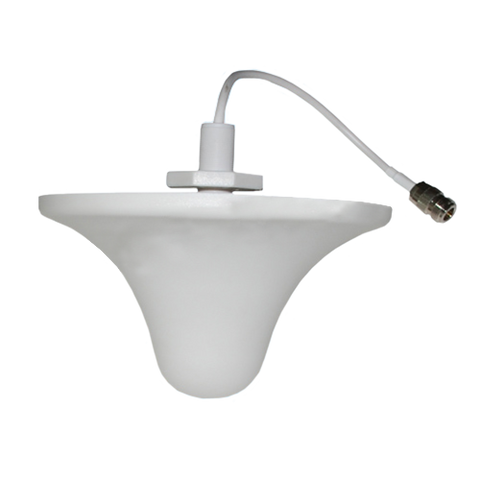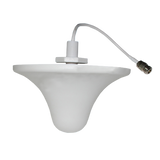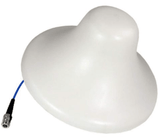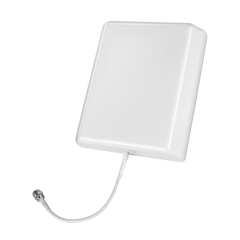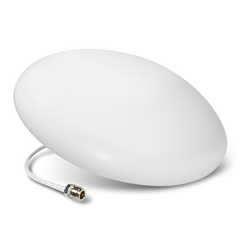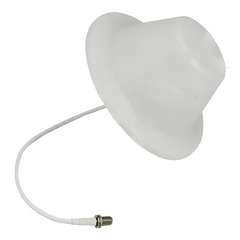Public Safety Antenna for Distributed Antenna Systems (DAS)
Public Safety Antenna for Distributed Antenna Systems (DAS)
Buy Now, Pay Later with No Interest if paid in full within 6-12 months. Choose Klarna payment option at the checkout for details of this, and other long-term low-interest financing options.
Free Lifetime Support. SKU / Model: AFCAC0460G4NFP8
380-520 MHz/ 698-960 MHz/ 1710-6000 MHz Low PIM Public Safety Ceiling DAS Antenna:
Ultra Wide Band and Low PIM Omni-Directional Dome Antenna covers the 380 MHz UHF band commonly used by police, fire safety and first responders up to the 4.9 GHz Public Safety bands as well as covering the 2.4 to 6 GHz WiFi bands.
1(855)846-2654
Need installation quote, or help with designing a custom solution? Submit a request for quote.
- Description
- Reviews
- Questions & Answers
- Make An Offer
- Warning
Description
Product Description
Premium quality Low-PIM 50 Ohm Public Safety Antenna for Distributed Antenna Systems (DAS) is an Ultra-Wideband Antenna that provides optimum coverage for large indoor spaces as well as large open areas such as stadiums and warehouses. It covers frequency bands 380 MHz to 6000 MHz commonly used by fire safety, police and first responders.
DAS stands for "distributed antenna system". PIM stands for "passive intermodulation" (explained in detail at bottom). This is our premium signal booster custom pallet # 8 inventory item: Public Safety Antenna for Distributed Antenna Systems (DAS) with UPC 697691010458.
This High Performance Ceiling Antenna provides Ultra Wideband omnidirectional coverage from 380MHz to 6 GHz, while its radiation pattern is optimum for in-building Public Safety Distributed Antenna System (DAS). It is used by our installers when providing public safety DAS installation service.
This public safety bands antenna, with its 12 inches diameter, is ideal for DAS networks used for Public Safety, WiFi and Cellular 2G, 3G, 4G, LTE signals through buildings or other structures. The anti-PIM design results in an accurate omnidirectional pattern in the vertical plane. The slight tilt downwards minimizes the effects of PIM while providing excellent coverage for big open areas, including as stadiums and warehouses.
It covers the lower 380 MHz, 450 MHz, 600 MHz and 700 MHz bands normally used by first responders, police and fire safety. The cellular range from 698 to 2700 MHz as well as the 4.9 GHz Public Safety bands are also covered, plus the 900 MHz, 2.4 GHz, 3.65 GHz and 5 GHz WiFi bands.
The white radome is attractive and blends in with most residential, public, and commercial environments. It can be mounted through a small hole in drop ceiling tiles without any backing plate. It can also be mounted in a covered area outdoors.
The 9.5 inch antenna lead is plenum rated with low PIM is terminated with a quality N-Female connector. Custom connectors, including 7/16 DIN, are available.
Features.
- Mounts to Ceiling Tile Easily.
- Ultra-Wideband Coverage (380-6000 MHz).
- Low Passive Inter Modulation (PIM).
- Lightweight.
- Broad Omnidirectional Coverage.
- 50 Ohm N Female Connector.
- Low-PIM Design Reduces Signal Interference.
Applications.
- Police and Fire Communications.
- Public Safety DAS Systems.
- Small Cell and SISO IDAS.
- PCS, GSM, UMTS, DCS and AWS-3.
- 2G, 3G, 4G and LTE Cellular Bands.
- 802.11ac and 802.11a/b/g/n WiFi.
- UHF Repeaters.
Specifications:
| Frequency Range | 380-6000 MHz |
|---|---|
| Gain | 2 - 6 dBi |
| Polarization | Vertical |
| Horizontal Beamwidth | 360 Degrees |
| Vertical Beamwidth | 90 / 35 Degrees |
| PIM, Carrier (2 x 43 dBm) | -153 dBc |
| VSWR | < 3:1/2:1 |
| Impedance | 50 Ohm |
| Cable length | 9 .5 Inches (241.3 mm) |
| Standard Connector | Type N Females |
| Maximum Power | 50 Watts |
| Dimensions | 11.7 x 6 Inches (298 x 152 mm) |
| Maximum Ceiling Thickness | 1 Inch (26 mm) |
| Temperature Range | -40°F to 140°F (-40°C to 60°C) |
| Weight | 1.8 Lbs. (0.82 Kg) |
| Lightning Protection | DC Short |
What does Low-PIM Antenna Mean?
To understand what Low PIM antennas mean, we must first understand what is PIM or Passive Intermodulation.
What is PIM and What Causes It?
PIM stands for Passive Intermodulation. In wireless infrastructure, PIM is measured in dB's and typically occurs when two or more signals are present in a passive, non-linear element or device, such as a DAS solution. PIM occurs when signals mix together in elements typically expected to operate in a linear manner, thus generating unwanted signals related to the original signals.
PIM has become a growing concern for cellular network operators, with problems occurring due to the ageing of existing equipment, when installing new equipment, or when co-locating new carriers. It’s of particular concern when duplexing new carriers into old antenna runs.
This intermodulation distortion occurs in components typically described as linear, such as antennas, connectors, and cables. However, these devices are capable of generating intermodulation signals at -80 dBm and even higher when exposed to high RF powers found in cellular systems.
For cellular operators trying to maximize the reliability, capacity, and data rate of their network, not to mention their return on investment, PIM is a very serious issue.
As the industry decides on the new "standard" RF connector, let us look at the difference between low PIM and high PIM.
- Low PIM means happy customers and improved revenues for carriers, because users receive strong signals with more bandwidth.
- High PIM means lost customers for the carrier, because the end-user receives limited bandwidth and poor cellular reception.
What Does This Mean?
It means that, from a hardware point-of-view, the design intention of every connection must be to minimize PIM and all connections must be tested to ensure correct installation. PIM testing is all-important to both design and installation processes to ensure top performance from the system. With today’s high-speed digital data communications, PIM testing has become critical. Because high transmitter power creates PIM, on-site testing should be carried out either at, or above, regular transmitter power levels to ensure PIM issues will be revealed.
Reviews
Questions & Answers
QUESTIONS & ANSWERS
Have a Question?
Be the first to ask a question about this.
Data Sheet / User Guide
Make An Offer
Warning
Note: For any signal booster to help, outside signal strength must be at least -110 dB or there must be a clear line of sight to a cell tower that is within twenty miles. Before ordering, please check outside signal level in decibels or ensure that you can make and hold a phone call at any good spot outside where you can mount an exterior antenna. Square footage stated in signal booster listings is based on good signal outside. If it is any weaker, the boosted sq. ft. area will be considerably lower, accordingly.
Kevin K. of Anderson, California gave the following review:
Website is easy to use with plain straight forward info but could have had more on testing signal strength to make sure you get a strong enough booster.
Therefore, please note that stated sq. ft. coverage is based on good signal outside. For best results: If outside signal is weak, we suggest choosing the next higher sq. ft. coverage kit. If outside signal is very weak, we suggest choosing the kit with even more higher sq. ft. range bracket. Basically, higher the sq. ft. bracket, the more powerful the signal amplifier with greater Gain as well as higher uplink and downlink output power.
If outside signal is too weak (weaker than -110 dB), submit request for cell coverage solution assessment. Upon receipt of questionnaire, we will perform residential or business site survey. This will help us determine the system that is needed to improve cell coverage. Then, we will create system design using that system such as femtocell, active or hybrid distributed antenna system (DAS), or other carrier feed signal enhancing method available that will work at your signal-challenged location. Finally, we will schedule for installation after equipment and installation service quote has been approved by you, or your company.
For non installation-included kits: Most home / office / building cell signal booster kits only include bracket to mount exterior antenna on outside wall, edge of roof, or existing pipe up to 2 inches in diameter. Mounting pole not included with most kits, unless stated specifically that it is included for free. Therefore, a mounting post must be purchased separately if you will require it to mount exterior antenna.

Related Products


